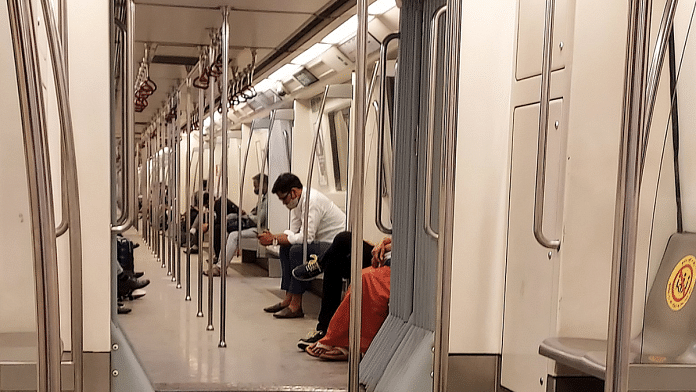New Delhi: Everyone stopped to stare at Mohit Gohar as he entered the Delhi Metro in his grey tracksuit, clutching a toothbrush, his hair all dishevelled. Moments later, he started brushing his teeth while his friend captured the act on a smartphone. Bored commuters started giggling; a few were aghast. When Gohar uploaded the clip on Instagram it got 13 lakh views and 81,000 likes.
Such love for metro Reels got too much for the DMRC. The Delhi Metro Rail Corporation recently reiterated its ban on the “filming of reels, dance videos, and any such activities that may cause inconvenience to passengers”.
There was a time when the DMRC was grappling with people jumping in front of the train. As many as 83 people died by suicide between 2014 and 2018, according to a report by The Indian Express. Now, Reels have become a new problem. The DMRC says it decided to ban Reels in the interest of passengers.
“People travelling in the metro were having trouble with such videos. The priority of [the] DMRC is [to ensure] that passengers [do] not face any problem. The motive of this ban is also the same,” says Anuj Dayal, head of corporate communications, DMRC.
The New York Police Department had waged a similar war on subway dancers a decade ago, and that was before TikTok became popular. Today, reels have made mass transit systems across the world—be it the London Underground or the New York Subway—a hotspot for dancers and content creators.
Also read: Gen Z has found a keeper in Spotify, Apple podcasts. Navya Nanda, Ahsaas Channa…
Mixed reactions
Commuters have mixed feelings toward the DMRC ban. Sonia Sharma, 28, works at a corporate firm in Gurugram and commutes from Subhash Nagar to Huda City Centre every day. She said there were days when the ‘acts’ angered her. But now that they are banned, she misses them. “It used to make me happy hearing the songs in the crowded metro after a tiring day,” she says. Now she enjoys watching metro Reels on her phone.
Meanwhile, some think that content creators making Reels in the metro are a noisy distraction after a long day at work. Rahul Kumar, 28, who commutes from Dwarka to Mandi House every day, is happy with the ban. “A group of people used to sing and dance. But the metro is for travelling. There are other places to dance and sing. They should go there and do all this,” he says.
Also read: India has no TV, OTT content for its nearly 50 crore GenZs. It’s still…
Go-to spot for creators
In a city teeming with crowds, open drains, and encroached sidewalks, where the river runs dirty and the air chokes, the metro is a haven. Its clean stations, walkways, and coaches make it the perfect spot for Reel addicts hunting for new backdrops.
Instagram, YouTube, and Facebook are overrun with thousands of videos shot inside the train or on station platforms. Dance performances are a hit; clips of trains entering the station against a background of music or poetry are equally popular.
The Delhi Metro also allows creators to interact with their audience—from school children to couples to senior citizens.
“Content creators making Reels in the outdoors often look for something different to attract people. Parks and roads have become old. There is a feel of foreign countries in the metro, and the reactions of the public are also visible,” says a content creator who did not want to be named.
A viral Reel uploaded on 10 March shows a young mother carrying her toddler in her arms. She describes how difficult the act is — trying to entertain the child while sitting on the floor of the coach to shoot a Reel. The camera captures reactions from passengers as well, most of whom seem disinterested, or studiously look away.
In another Reel, a group of boys give an off-key rendition of the song Shri Ram Janaki, Baithe Hain Mere Seene Mein in a crowded coach.
Rajni Chaudhary, a credit card sales executive working at Rajiv Chowk, can identify people who use the metro just to make Reels.
“I often see groups of young people talking about taking the cheapest coupon and making a Reel,” she says. Since the ban, she has been seeing only a few metro content creators. “But it has not stopped completely. Some start dancing at the station until the CRPF (Central Reserve Police Force) men drive them away.”
Too many rules?
On a Friday evening, two men break away from the crowd at Rajiv Chowk metro station. They quickly scan the station for guards and security personnel as they move toward a billboard.
One man pulls out his phone and starts filming his friend who walks in front of the billboard, a jacket flung on his left shoulder. He walks with the confident swagger of a hero. And it’s a wrap.
“There are so many metro stations, and it was a short video. I don’t think it’s a problem for anyone. Itna rules follow karenge to kaise jiyenge (How will we live if we follow so many rules?),” says the ‘cameraman’.
(Edited by Humra Laeeq)






